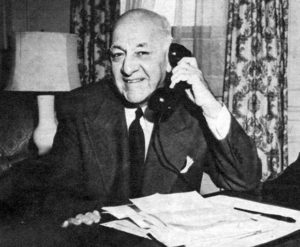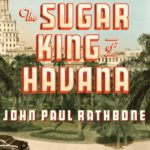 JULIO LOBO, EL NACIONALISTA Y DESTACADO ZAR DE LA INDUSTRIA AZUCARERA CUBANA.
JULIO LOBO, EL NACIONALISTA Y DESTACADO ZAR DE LA INDUSTRIA AZUCARERA CUBANA.
Julio Lobo y Olavarría nació un 30 de octubre de 1898 en Caracas, Venezuela, pero su familia se establecio en La Habana desde que todavia Julio no cumplia un año, convirtiendose con los años en un poderoso comerciante y financiero cubano de la Industria Azucarera en el pais.
Corría ya el año de 1920 cuando Julio que se habia diplomado como ingeniero agrónomo en los Estados Unidos regresó a Cuba y asumió la dirección general de Galbán, Lobo y Compañía que le dió inicío de su futuro imperio azucarero del cual llegó a convertirlo en uno de los hombres más ricos de Cuba. En ese entonces se casó con bella joven de una vieja familia aristocrática cubana, la familia Montalvo.
Julio Lobo llegó a poseer 14 ingenios azucareros, más de 30,000 acres de tierra, un banco, una compañía de seguros y oficinas en La Habana, Nueva York, Londres, Madrid y Manila; una agencia de radiocomunicaciones, una naviera, una aerolínea, una compañía de seguros y una petrolera. Era el principal vendedor de azúcar en el mercado mundial.
Guillermo Jiménez, en su libro Los propietarios de Cuba, atribuye a Lobo una fortuna personal de 85 millones de dólares, con activos calculados en cien millones. Rathbone, su biógrafo, asegura en su libro que si esa fortuna se midiera con los parámetros actuales ascendería a no menos de cinco mil millones.
Nunca quiso intervenir en política, pero fue un enemigo acerrimo del dictador de turno Fulgencio Batista y se mostraba partidario de la democión de Batista, sin importante quién lo sucedería.
En 1957 entregó 50 mil pesos para la Organizacion revolucionaria cubana “Acción Libertadora”, una organización antibatistiana, que pasó a su vez la mitad de ese dinero al Movimiento de Castro ’26 de Julio’.
Asegura Rathbone, su biografo en su libro “Julio Lobo, The Sugar King of Habana” que ya triunfada la Revolucion Castrista en Cuba el entonces comandante Ernesto Che Guevara lo convocó a su oficina. El comandante guerrillero devenido entonces presidente del Banco Nacional de Cuba le dijo que habían revisado sus cuentas y que lo felicitaba por la eficiencia de sus empresas y por no deberle un solo centavito al fisco, pero le comunicó que sus bienes serían intervenidos.
Le hizo una oferta: Podía permanecer al frente de sus centrales azucareros. A cambio recibiría un salario del Estado. De más está decir que Lobo se negó. En pocos meses abondonaria al país.
LA VIDA DE JULIO LOBO EN CUBA.
A diferencia de la familia millonaria de los Falla Bonet que al triunfar la Revolución sacaron de Cuba no menos de cuarenta millones de dólares, Julio Lobo, furibundo nacionalista, siguió invirtiendo en la industria azucarera y en otras empresas, al tiempo que continuaba agrandando sus valiosas colecciones de arte. Al fin y al cabo, siempre había sido más listo que sus rivales y esa confianza lo llevó a no tomar precaución alguna.
Muy polémica fue, en 1958, la compra por parte de Lobo de los tres ingenios propiedad de la Empresa Norteamericana Hershey. Compra esa que le costó muy cara pues ya fuera de Cuba sus acreedores le exigieron la deuda pendiente de aquellos centrales que ya no eran suyos.
Su biblioteca especializada en temas azucareros era la mejor y más completa de Cuba y tal vez de todo el mundo. Sobresalían en su pinacoteca obras de Da Vinci, Rafael, Miguel Ángel y Goya, entre otros grandes pintores, y era famosa su colección de incunables y de libros únicos y raros.
Lo obsesionaba la personalidad de Napoleón, de quien llegó a poseer una amplia colección de reliquias y más de 200 mil documentos, que dejó a la nación en depósito y que se atesoran hoy en el Museo Napoleónico de La Habana.
Le interesaban asimismo los temas hispanoamericanos. Lobo fue un hombre del Renacimiento, dice Rathbone, extremadamente curioso, con un profundo conocimiento de los negocios, del tema del azúcar, la política y la historia y una impactante cultura general.
Julio Lobo nunca tuvo un yate propio y apenas hizo vida social. Fue un trabajador compulsivo de hasta 16 horas diarias. Su hobby era la jardinería.
Tenía además la afición de coleccionar actrices de Hollywood. Con Joan Fontaine tuvo una relación prolongada y llegó a proponer matrimonio a Bette Davis. En cierta ocasión ordenó que llenasen con agua perfumada una de sus piscinas para agasajar a la estrella de cine y diva del nado sincronizado Esther Williams.
De cualquier manera, en 1960, Lobo salió de La Habana, diría él mismo, con una maleta pequeña y un cepillo de dientes. Se instaló en Nueva York y continuó en el giro del azúcar, pero nunca repitió sus pasadas hazañas. Cuando falleció, en 1983, su capital, dice Rathbone, se estimaba en 200 mil dólares. En realidad, precisa el biógrafo, muy pocos prosperaron en el exilio.
Pasó sus últimos años al cuidado de su primera esposa, de la que se había divorciado muchos años antes. Ya para entonces solo podía mover los ojos. Lobo murió en Madrid, España el 30 de Enero de 1983 y fue enterrado en la Catedral Almudena cerca del Palacio Real español.
Pidió que lo inhumaran en guayabera y que una bandera cubana cubríera su ataúd. Ese fue su último deseo.
 JULIO LOBO, THE NATIONALIST AND DISTINGUISHED CZAR OF THE CUBAN SUGAR INDUSTRY.
JULIO LOBO, THE NATIONALIST AND DISTINGUISHED CZAR OF THE CUBAN SUGAR INDUSTRY.
Julio Lobo y Olavarría was born on October 30, 1898, in Caracas, Venezuela, but his family settled in Havana since Julio was not yet a year old, becoming over the years a powerful Cuban merchant and financier of the Sugar Industry in the country.
It was already the year of 1920 when Julio, who had graduated as an agricultural engineer in the United States, returned to Cuba and assumed the general direction of Galbán, Lobo, and Company, which gave him the beginning of his future sugar empire, which he became one of the richest men in Cuba. At that time he married a beautiful young woman from an old Cuban aristocratic family, the Montalvo family.
Julio Lobo came to own 14 sugar mills, more than 30,000 acres of land, a bank, an insurance company, and offices in Havana, New York, London, Madrid, and Manila; a radiocommunications agency, a shipping company, an airline, an insurance company and an oil company. It was the main seller of sugar in the world market.
Guillermo Jiménez, in his book The Owners of Cuba, attributes to Lobo a personal fortune of 85 million dollars, with assets calculated at one hundred million. Rathbone, his biographer, assures in his book that if that fortune were measured with current parameters it would amount to no less than five billion.
He never wanted to intervene in politics, but he was a bitter enemy of the dictator on duty Fulgencio Batista and was in favor of Batista’s demotion, no matter who would succeed him.
In 1957 he gave 50 thousand pesos to the Cuban revolutionary organization “Acción Libertadora”, an anti-Christian organization, which in turn passed half of that money to the Castro Movement “July 26”.
Rathbone, his biographer in his book “Julio Lobo, The Sugar King of Habana” assures that the Castro Revolution in Cuba had already triumphed, and then Commander Ernesto Che Guevara summoned him to his office. The guerrilla commander then became president of Banco Nacional de Cuba told him that they had reviewed his accounts and that he congratulated him on the efficiency of his companies and for not owing to the Treasury a single penny, but he informed him that his assets would be intervened.
He made him an offer: He could remain in charge of his sugar mills. In exchange, he would receive a salary from the State. Needless to say, Lobo refused. In a few months, he would leave the country.
THE LIFE OF JULIO LOBO IN CUBA.
Unlike the millionaire family of the Falla Bonet who, when the Revolution triumphed, took out no less than forty million dollars from Cuba, Julio Lobo, a furious nationalist, continued to invest in the sugar industry and other companies while continuing to expand his valuable art collections. After all, he had always been smarter than his rivals, and that confidence led him to take no precautions.
Very controversial was, in 1958, the purchase by Lobo of the three mills owned by the North American Company Hershey. He bought that one which cost him dearly since outside of Cuba his creditors demanded the outstanding debt of those plants that were no longer his.
Its library specialized in sugar subjects was the best and most complete in Cuba and perhaps in the whole world. Works by Da Vinci, Rafael, Miguel Ángel and Goya, among other great painters, stood out in his gallery, and his collection of incunabula and unique and rare books was famous.
He was obsessed with the personality of Napoleon, from whom he came to possess a vast collection of relics and more than 200,000 documents, which he left the nation in deposit and which are hoarded today in the Napoleonic Museum in Havana.
He was also interested in Hispanic American issues. Wolf was a Renaissance man, says Rathbone, extremely curious, with a deep understanding of business, the subject of sugar, politics and history and striking general culture.
Julio Lobo never had a yacht of his own and hardly made a social life. He was a compulsive worker of up to 16 hours a day. Her hobby was gardening.
He also had a fondness for collecting Hollywood actresses. He had a long relationship with Joan Fontaine and came to propose to Bette Davis. On one occasion he ordered one of their pools to be filled with scented water to entertain movie star and synchronized swimming diva Esther Williams.
Either way, in 1960, Lobo left Havana, he would say himself, with a small suitcase and a toothbrush. He settled in New York and continued on the sugar tour, but he never repeated his past exploits. When he died in 1983, his capital, Rathbone says, was estimated at $ 200,000. In reality, the biographer points out, very few thrived in exile.
He spent his last years in the care of his first wife, from whom he had divorced many years before. By then I could only move my eyes. Lobo died in Madrid, Spain on January 30, 1983, and was buried in the Almudena Cathedral near the Spanish Royal Palace.
He asked to be buried in a guayabera and for a Cuban flag to cover his coffin. That was his last wish.
Agencies/ Wiki/ RHC/ Extractos/ Excerpts/ Ciro Bianchi/ Internet Photos/ Arnoldo Varona/ www.TheCubanHistory.com
THE CUBAN HISTORY, HOLLYWOOD.












